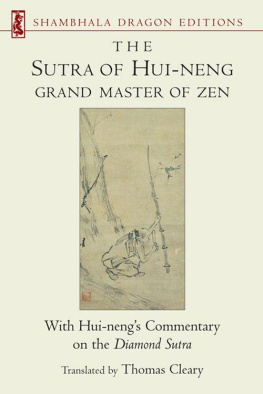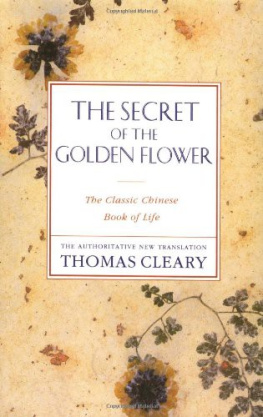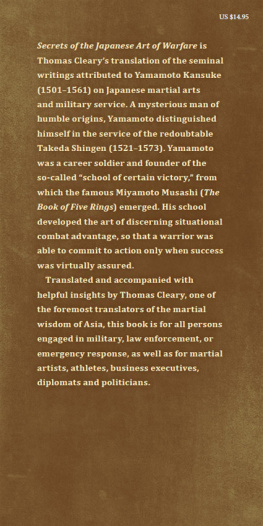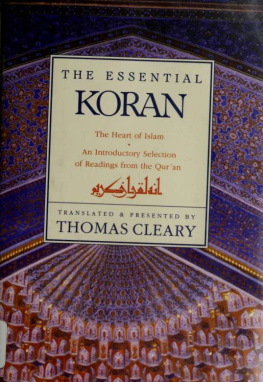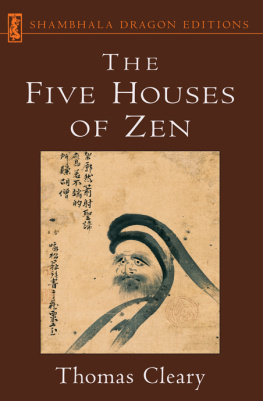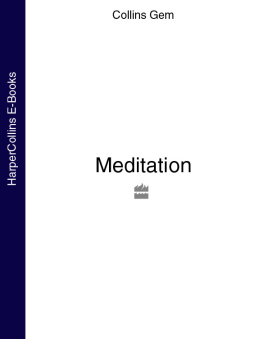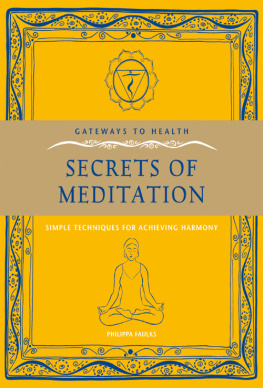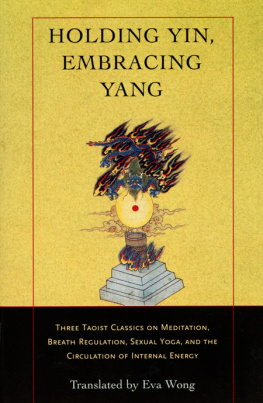Thomas Cleary - Meditation and Health
Here you can read online Thomas Cleary - Meditation and Health full text of the book (entire story) in english for free. Download pdf and epub, get meaning, cover and reviews about this ebook. year: 2011, genre: Religion. Description of the work, (preface) as well as reviews are available. Best literature library LitArk.com created for fans of good reading and offers a wide selection of genres:
Romance novel
Science fiction
Adventure
Detective
Science
History
Home and family
Prose
Art
Politics
Computer
Non-fiction
Religion
Business
Children
Humor
Choose a favorite category and find really read worthwhile books. Enjoy immersion in the world of imagination, feel the emotions of the characters or learn something new for yourself, make an fascinating discovery.

- Book:Meditation and Health
- Author:
- Genre:
- Year:2011
- Rating:5 / 5
- Favourites:Add to favourites
- Your mark:
- 100
- 1
- 2
- 3
- 4
- 5
Meditation and Health: summary, description and annotation
We offer to read an annotation, description, summary or preface (depends on what the author of the book "Meditation and Health" wrote himself). If you haven't found the necessary information about the book — write in the comments, we will try to find it.
Meditation and Health — read online for free the complete book (whole text) full work
Below is the text of the book, divided by pages. System saving the place of the last page read, allows you to conveniently read the book "Meditation and Health" online for free, without having to search again every time where you left off. Put a bookmark, and you can go to the page where you finished reading at any time.
Font size:
Interval:
Bookmark:
Meditation and Health
Principles and Practices
Translators Introduction
With traditions going back thousands of years, Taoism (Daoism) is one of the oldest practical philosophies in the world. Over the ages Taoism has adopted many different forms, using a wide range of terminologies and pursuing a broad spectrum of interests in social, psychological, artistic, scientific, and spiritual concerns.
One of the main branches of scientific interest pursued by Taoists over the ages has been medici ne and healing. In its popular outreach to society at large, Taoism is often distinguished by an abiding emphasis on health, well being, and lengthening life.
This book is about Taoist methods of silent healing and life prolongation as they are practiced in modern times.
A fundamental principle of Taoist healing is based on conservation of internal energy to maximize the natural self-renewing capacity of the bodys life processes. The aim of the practices is to foster the efficiency of natural recuperative powers by resolving and releasing unnatural inhibitions on their functions imposed by accumulated effects of chronic excesses of expenditure and stress. Restoration and wellness are cultivated by way of calming methods used to dissolve tension and stress and develop feelings of freedom and ease. Conscious breathing is used to refine body awareness in this process, while other exercises linking mind and body are used to stimulate circulation and promote mental and physical energy.
The health exercises described in this book generally fall into two categories, one conventionally called life and the other essence. In terms of therapeutic effect, life-oriented exercises influence the mind through the body, while essence-oriented exercises influence the body through the mind. Some exercises work on body and mind together, going in both directions at once. Whichever approach is taken at the outset, depending on individual needs, the goal is balanced integration of these elements, insofar as the effects of silent healing come from the interaction of body and mind.
Taoist practitioners describe two basic approaches to stimulating the healing response, corresponding to these categories of life and essence.
Life exercises stimulate the nervous system to foster new body awareness with enhanced energy, improving circulation and increasing resistance to illness.
Essence exercises promote mental and physical relaxation, reducing stress to help maximize natural recuperative powers.
When combined, these practices are believed to help heal the body, relieve the mind, and lengthen life.
Mind-Body Fusion: Energy Circulation Exercises
The cultivation of energetic awareness of the body for the purposes of health exercises is referred to by special terms alluding to internal mind-body experiences, commonly called the opening, or clearing, of channels, apertures, and passes.
In terms of sensation, the energy channels may be described as lines of awareness, while the apertures (or openings) and passes may be described as points of awareness and spaces of awareness. Focus on these lines, points, and spaces produces special states of consciousness and body awareness used for energizing and healing.
There are many variations in usage and application of these so-called channels, apertures, and passes, but the basic system from which these variations are derived is essentially the same.
Taoist practitioners who work with energy channels generally refer to two, three, or eight channels. Most such exercises begin with opening the two principal channels known as the active and passive channels.
It is held that the other channels may open spontaneously after the active and passive channels are opened, so there are many cases where these two are the only channels actually mentioned in a given exercise or program.
In general terms, the active channel is sensed as following the spine from the base of the torso up to head. The passive channel follows the corresponding route from the head down the front of the body, rejoining the active channel at the base of the torso.
Circulation of energy up the active channel and down the passive channel is metaphorically referred to as activation of the waterwheel, this association being intended to convey the image of energy being brought up and poured down in a repeated cycle within the body.
The circulation of energy through the channels is initiated by opening the apertures and passes, which are key points along the channels.
These apertures and passes are opened by storing internal energy in critical points in the network called elixir fields. These elixir fields are located in the abdomen, thorax, and head, sensitive areas where Taoist practitioners who use this system focus their attention to collect and cull energetic sensations.
Apart from the active and passive channels, the other channels are mentioned less frequently. The thrusting channel is in the center of the body, between the active and passive channel, going directly from the perineum to the top of the head. The girdling channel circles the body around the waist, curving down from about two inches below the ribs at the sides to the level of the bladder in front.
The other four channels run from the feet into the head: two go up the outsides of the legs and along the sides, shoulders, and neck; two go up the insides of the legs and along the abdominal muscles, chest, and throat.
In terms of awareness, these tie the limbs to the torso of the energetic body-sense, creating long lines of continuity of consciousness that can be used to cultivate grace and economy of movement, increasing strength and efficiency without increasing energy expenditure.
Just as there is no material medicine in any system without limitations and possible side effects, there are also standing controversies and cautions connected with Taoist practices and experiences associated with opening energy channels, apertures, and passes. This is not peculiar to Taoism, as similar caveats surround the use of parallel systems in other traditions, just as critical caveats attend the employment of all ordinary medicines, even something as seemingly simple as aspirin, as well as every kind of energy in everyday use, from electricity to combustion to nuclear fission. In the practical context of healing, the critical issue is whether or to what degree a certain method will effectively help a particular person to be well.
In Taoism it is generally recognized that this is a question of fact , which therefore differs according to individual constitutions and conditions. These variables have given rise to many differences in actual practice. Those who contemplate using any of the exercises described herein are therefore advised to discuss them with their health care providers. Well-known systems such as Tai-chi-chuan are referred to generically, as instruction in their forms is widely available.
The nonphysical and mentally formless element of Taoist healing is customarily treated with less reserve, for several reasons. It is commonly considered safer and less conducive to harmful side effects. What is more, this nonmaterial element is also a necessary ingredient of the energetic and physical dimension of healing.
This is the meditative dimension of Taoist practice where Taoism and Chan Buddhism intersect, so there are also many references to Buddhist findings in connection with essence-oriented exercises.
As a practical approach to life, Taoism is preeminently a path of peace and well being, perhaps for the very reason that its philosophy was forged in the midst of chronic warfare and destruction. This book contains translations from conversations of 20th century Taoists, who like many of their spiritual ancestors lived through times of turmoil and total warfare.
Next pageFont size:
Interval:
Bookmark:
Similar books «Meditation and Health»
Look at similar books to Meditation and Health. We have selected literature similar in name and meaning in the hope of providing readers with more options to find new, interesting, not yet read works.
Discussion, reviews of the book Meditation and Health and just readers' own opinions. Leave your comments, write what you think about the work, its meaning or the main characters. Specify what exactly you liked and what you didn't like, and why you think so.

